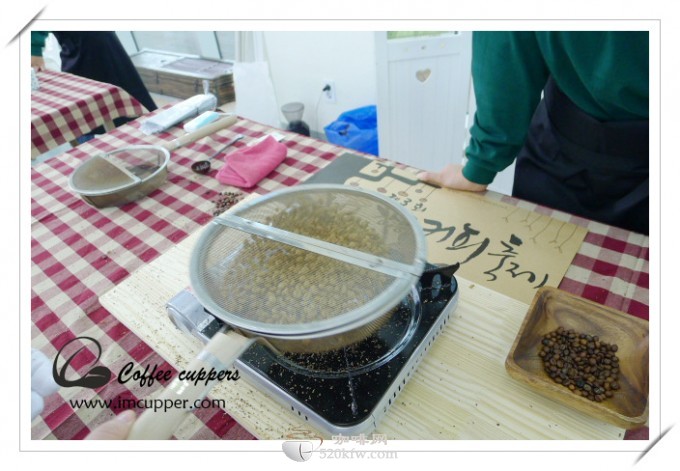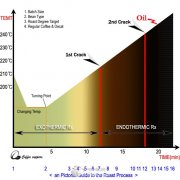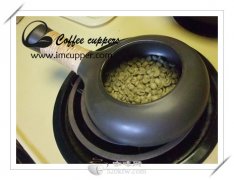Coffee bean baking technology net spoon baking process

Coffee roasting (coffee roasting) refers to the heating of raw beans to convert starch in raw beans into sugars and acids at high temperature, cellulose and other substances will be carbonized to varying degrees, water and carbon dioxide will be volatilized, protein will be converted into enzymes and fats, and the remaining substances will be combined to form an oil film on the surface of coffee beans, and in this process will produce sour, bitter, sweet and other flavors of coffee. The process by which raw beans are converted into dark brown beans by forming a mellow degree and hue. Because a variety of small changes in temperature, heat and other small changes in the baking process can change the taste of beans, different beans have different characteristics, and baking is a fast operation in a short time, so it is required to accurately budget the baking process and adjust it timely.
Net spoon roasting is the most economical way to roast coffee with a net spoon in the home kitchen. Spoon roasting varies according to the amount of coffee beans roasted, firepower, seed, room temperature, roasting skills and preferences. Take 150 grams of coffee beans as an example, the first explosion is usually about 10 minutes; the second explosion is about 15 minutes. If you feel that the heat is easy to master, you can use a thermometer with a probe to control the baking temperature and baking effect.
The operation method and steps of roasting coffee beans with a net spoon:
1) put the raw beans into a filter with a handle and close the lid. Adjust the fire to medium fire, hold the filter at the top of the fire 20 cm to 30 cm, repeatedly and evenly make a circular swing to make the water evaporate.
2) when the beans are heated for 3 to 5 minutes, a small part of the silver skin begins to fall off and a fishy smell floats out. If the silver skin falls out in large quantities, the dehydration will soon be completed, and there will be a sweet smell. When the sweet taste begins to be slightly scorched, the color of the coffee beans becomes bright yellow.
3) the dehydrated coffee beans continue to bake, making a "crackling" sound, and there is a faint white smoke coming out, which is the "explosion".
4) about 10 seconds to a few minutes after the first explosion, the coffee beans will smoke again and produce a lighter "crackling" sound than the first explosion, which is called the "second explosion". At this time, the smell of the coffee beans is all released, and the roasting process of the coffee beans can be over.
5) after the second explosion, you can choose to continue baking or "baking beans" according to your personal taste. After pouring the coffee beans into the plate, use the cold air of the fan or fan to cool them quickly and bake them.
After baking, once again confirm whether there are secondary beans and unroasted coffee beans, if any, pick out the fried coffee beans and store the fried coffee beans in a bottle or can for 1 or 2 days.
Important Notice :
前街咖啡 FrontStreet Coffee has moved to new addredd:
FrontStreet Coffee Address: 315,Donghua East Road,GuangZhou
Tel:020 38364473
- Prev

Roasting technology of boutique coffee reactions and changes in the roasting process of coffee
Coffee roasting (coffee roasting) means that through heating raw beans, starch in raw beans is converted into sugars and acids at high temperature, substances such as cellulose will be carbonized to varying degrees, water and carbon dioxide will be volatilized, proteins will be converted into enzymes and fats, and the remaining substances will be combined to form an oil film on the surface of coffee beans, and in the process coffee acids will be formed.
- Next

Coffee beans Roasting technology Ceramic coffee roasters
Coffee roasting refers to the heating of raw beans to convert starch in raw beans into sugar and acidic substances at high temperature. Cellulose and other substances will be carbonized to varying degrees. Moisture and carbon dioxide will volatilize. Protein will be converted into enzymes and fats. The remaining substances will combine together to form an oil film layer on the surface of coffee beans. In the process, coffee acids will be generated.
Related
- What is the meaning of lactic acid fermentation with coffee bean treatment?
- How to judge the state of foam by sound?
- How does the latte pull out the unicorn pattern? Come to get for a little trick to improve the flower pull!
- Will flower pulling affect the taste of the latte?
- Do you know the history of coffee?
- The difference between honey treatment and sun washing what is raisin honey treatment?
- What kind of milk can a novice use to make coffee foam to keep the foam longer? The correct method and skills of milking tutorial sharing
- Why do washed coffee beans taste sour? Flavor characteristics of washed Coffee
- Introduction to the skill of how to practice the size and height of water injection around the circle of hand-brewed coffee
- How do beginners practice coffee flower drawing from scratch?

